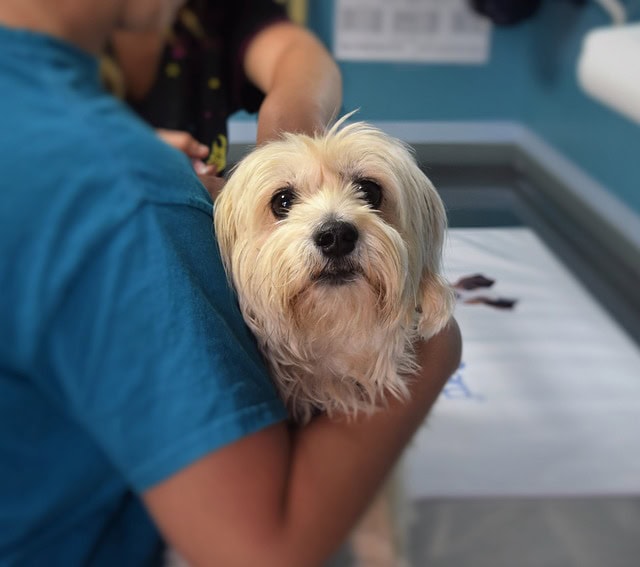
At two years of age, Sasha developed a flesh-colored bump on her hind leg that was less than an inch in diameter. Unless you groomed her, you wouldn’t notice it at all. In a month or two, the lump grew to four times its original size and was firm to the touch. Despite her lack of interest in the tumor and her normal demeanor, I was concerned about how quickly it grew.
At this stage, a biopsy of the lump was performed by the vet, and she was diagnosed with mast cell cancer.
Pay Attention to Unusual Lumps and Bumps

Cancer is a horrible disease that can easily go unnoticed before it starts to spread and cause uncomfortable symptoms for pets. Not all lumps and bumps are round and hard growths, either. Some develop into a fluid-filled swelling, while other cancerous tumors in dogs look like a harmless wart on the skin.
When you know what to look for, along with the assistance of your vet, you can determine the best treatment before you’re left with limited options. Nobody wants to hear that their pet could possibly have cancer, but the sooner you get a diagnosis of a suspicious-looking lump or bump, the earlier treatment can begin.
What Causes Cancer in Dogs?

There is no single answer as to what causes cancer in dogs. Unfortunately, we can’t pinpoint why specific breeds are more susceptible to cancer than others. Research into the causes of cancer in pets is ongoing, but it is believed to have a strong genetic component because certain breeds tend to suffer from cancer more than others.
There is the assumption that kibble diets which high in carbs, low in quality proteins, and contain chemical preservatives may contribute to cancerous tumors in dogs.
What Does a Cancerous Tumor Look Like?

It is important to pay attention to any lumps or warts that appear on your dog’s skin, but before you panic about finding a bump, not all growths are cancerous. To give your pooch the best chance, careful monitoring of a lump and a visit to the vet can assist in early detection and treatment. It can also put your mind at ease as to whether the lump is cancerous and requires further investigation.
The following signs should be investigated by your vet
The Mass Changes in Shape, Appearance, or Size
Any lump, wart, or skin tag that changes in shape or size must be examined by your vet.
The Mass Changes in Consistency
A lump that turns from hard and smooth to soft and swollen requires veterinary attention.
The Skin Surrounding the Mass is Abnormal
Certain types of growths are surrounded by inflamed skin. You may notice fine pimples or fluid-filled pustules around the mass. If the lump develops into a raw spot and doesn’t heal, it could be cancer or an infection. It is best to speak to your vet if you notice any of these changes.
Pets Become Preoccupied with the Mass
If your dog constantly licks and chews at the growth or rubs the area against objects for relief, pay attention to it. Licking and chewing can also cause additional irritation and increases the risk of infection.
Changes in a Mast Cell Tumor
The images below show the changes in the size and appearance of the mast cell tumor in Sasha’s hind leg over 3 months



Checking for Cancerous Lumps

Check your dog’s skin by running your hands along their neck, legs, stomach, and back. Be sure to inspect the inside of the ears and skin folds under their front and back legs. When you feel a pimple or bump, watch it. If it changes in color, shape, or size, get it examined by your local vet.
Needle Aspirate
If you are concerned about a lump or mass on your dog, ask your vet to perform a needle aspirate. It is completed during a regular appointment and involves the collection of cells examined under a microscope to detect abnormalities.
Biopsy
A biopsy is a more invasive procedure and is usually recommended by vets for large growths. During a biopsy, pets are sedated and a piece of the lump is removed for further testing.
Trust your gut…
If you feel that a lump, wart, or skin change is cause for concern, speak to your vet about it. The purpose of these checks is early detection and preventing the spread of cancer. Certain cancerous tumors in dogs can be successfully excised. This means that the cancerous tissue surrounding the mass is surgically removed.
To support your pooch’s immunity, place them on a nutritious dog cancer diet. Incorporate exercise and lots of play time to maintain their health and happiness.
Remember that not all cancers and cancerous tumors are visible on the skin. In Sasha’s case, the tumor on her hind leg grew deep within the tissues. It only became visible once it reached a considerable size, but by this stage, it couldn’t be removed.
When a tumor cannot be removed or the prognosis is poor, there are alternatives to surgery and invasive treatment. These alternatives include the dog cancer diet, turkey tail mushrooms, and THC to offer relief and slow the progression of cancer.
A cancerous tumor in your dog doesn’t mean the end. Take a deep breath and speak to your vet about the type of cancer. While surgery is best for cancerous lumps, consider the alternative therapies I discuss throughout this guide to move forward.